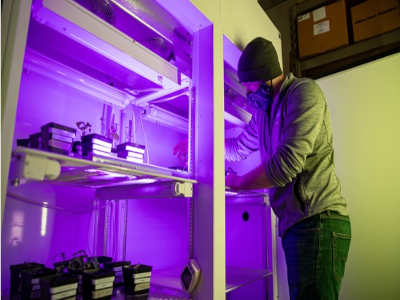If you want to learn how to farm successfully and grow crops, here’s a novel place to turn to:
The UND Department of Space Studies.
Then again, this advice might be a tad limited, given that not many are aspiring to grow crops on asteroids millions of miles from Earth.
But UND Assistant Professor of Space Studies Sherry Fieber-Beyer is. And in fact, she’s one of the first in her field who’s seriously looking into such an idea.
“If our goal is to establish a long-term presence in space, well, humans can’t do that unless we have food,” said Fieber-Beyer, a planetary scientist.
It turns out that among the vast combinations of rocky and metallic celestial bodies floating in our solar system, a number of them have a top soil – commonly referred to as regolith – that is highly organic. They’re classified as C-type asteroids.
So, in the greenhouse of UND’s Biology Department, a couple of otherwise normal-looking pots are the pilot testbeds of a far-off-in-the-future concept for space exploration.
Fieber-Beyer and Steven Russell, a Space Studies graduate research assistant, are studying whether lettuce, radishes and peppers are able to grow in a soil comprised of varying mixes of peat moss and simulated asteroid regolith, an exact mineral copy of samples taken from organic-layered C-type asteroids.
“It’s a pie-in-the-sky kind of idea,” remarked Fieber-Beyer, when asked about the practical application of farming asteroids. “But the end vision is to create pit stops for food throughout space.
“I don’t know of anybody else who’s growing plants in asteroid simulant at this moment, but I’m sure it will be an emerging field, based on calls for similar projects coming from NASA. And people are excited to see what happens through this experiment.”
Astronomical agriculture in the works
Though the experimental planting pots are described above as being normal-looking, they still stand out among the flora of the campus greenhouse. For example, one is situated at a 90-degree angle to the floor and slowly rotating to simulate growth conditions in microgravity.
In such an orientation, making a full 360-degree rotation over 24 hours, the plants actually grow perpendicular to the floor, in alignment with their container.
Russell, who’ll graduate soon with a master’s degree in Space Studies, has been the one maintaining and monitoring the planting process. The project is the topic of his thesis paper, which he’ll be wrapping up in the coming months.
With a biology degree from his undergraduate studies at UND, Russell was able to intern with scientists at NASA’s Kennedy Space Center in 2019, working with microorganisms in microgravity simulators. He was also in contact with scientists and fellow interns determining suitable plants for growth experiments on the International Space Station.
He said that the crop choices of lettuce, radishes and peppers had to do with how they each grow in soil and how they are harvested for consumption. Also, they have been previously grown in space, or are slated for experimentation, in the case of peppers.
As for the simulant, Fieber-Beyer procured the mineral mix from Exolith Lab, an extension of the Center for Lunar & Asteroid Surface Science at the University of Central Florida.
“We’re trying to grow these plants in different concentrations of asteroid simulant and Earth-based soil – peat moss – which is a common commercial planting medium,” Russell said. “The simulant on its own is very fine. If you put water in it, it’ll just seep through.”
Fieber-Beyer said that when the replicated asteroid material first arrived, she put both of her hands in it. “It got all over; it’s the blackest soil I have ever seen, and it immediately sent a dust cloud into the air,” she said with a laugh.
After weeks of monitoring the soil concentrations, ranging from 100 percent peat moss to 100 percent simulant in 25-percent increments, Russell said that mediums with up to 25 percent of simulant performed well for plant growth.
“I’ve noticed that the approach would probably need significant modifications, if we were to use it on a mission,” Russell said.
Further analysis of the soil, taken on by another lab outside of UND, will show the nutrient content of the compositions, as well as how effectively those nutrients can be transferred from soil to plant.

The experiments have taken place in such growth chambers at UND’s Department of Biology, where the environment is precisely regulated for testing combinations of simulant and peat moss planting mediums.